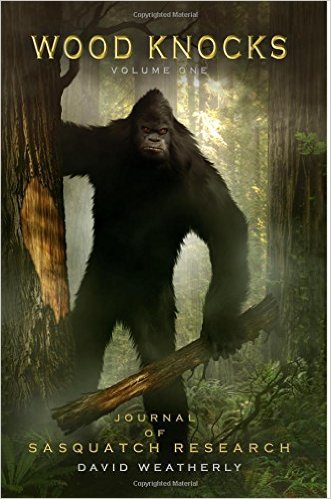
I have made my views on the creature known as Sasquatch plain in other articles for this blog. I have made it clear that I think that at least some of the giants people are seeing in the woods are kin to the Faery and do not belong completely to this world. In the parlance of modern paranormalists, I think Sasquatch is an inter-dimensional being that is capable of walking into our world and back out of it, pretty much at will.
That said, I greatly admire the work of the people who actually go into the woods looking for the creature and who spend their time talking to witnesses, setting camera traps and even flying drones hoping for a glimpse of the elusive ‘booger’. While I think that a lot of them just might be tilting at windmills, it is still admirable that they have the strength of their convictions and are willing to walk their talk.
The new anthology from Leprechaun Press, Wood Knocks, Volume 1: A Journal of Sasquatch Research is a collection of articles from the sorts of people who have devoted their lives to exploring the strange and especially to looking for cryptid creatures such as the Sasquatch. The anthology is an easy read, at just over 200 pages, so do not expect extensive or detailed articles, but it is packed with information that new and experienced Sasquatch aficionados will find interesting and informative. In my view, the cover art by Sam Shearon is worth the price of the book, all by itself.
The meat of the book is quite good as well. Whether we are talking Sasquatch amongst the First Nations people (David Weatherly) or hunting the Orang-Pendek in Sumatra (Richard Freeman) or talking about the presence of Sasquatch in Wisconsin and its surrounding areas (Linda Godfrey), the writing is, with one notable exception, crisp and there are cases in the book that I had not heard of, side by side, with some of the old standards. I enjoyed this chance to ‘touch base’ with the work of many authors that I admire and some that I did not know. Freeman’s article on the Orang-Pendek made me think that the Sumatrans may have a genuine undiscovered species in their midst.
Having said that, there is one article in the anthology that is a confused, rambling mess and could have easily been cut from the line up with no damage to the work. As I noted above, readers will be able to discern this one quickly and will have to decide for themselves whether the tidbits of information in the article are worth the pain of reading the disjointed ramblings of someone with entirely too much research and not enough space to present it cogently.
I would have been quite happy if that article had been cut and the other writers given more space to present their research. I had the feeling, in several of the sections, that the authors had a lot more to say but were unable to do so due to the editorial pen or space limitations or both. This is a real shame since, as I mentioned, there is quite a lot of original research amongst the articles. I would have been particularly interested to see Micah Hanks spin his thoughts on abductions out further and Nick Redfern’s article on infrasound was interesting but too short.
Wood Knocks is noted as volume 1 of a journal of Sasquatch research. If this is going to be a continuing series of works then the series is off to a good start and, with some minor tweaks, I can see such a series becoming a respected reference amongst those Sasquatch researchers willing to flex their minds a bit and look at new ideas, even if they do not agree with them.